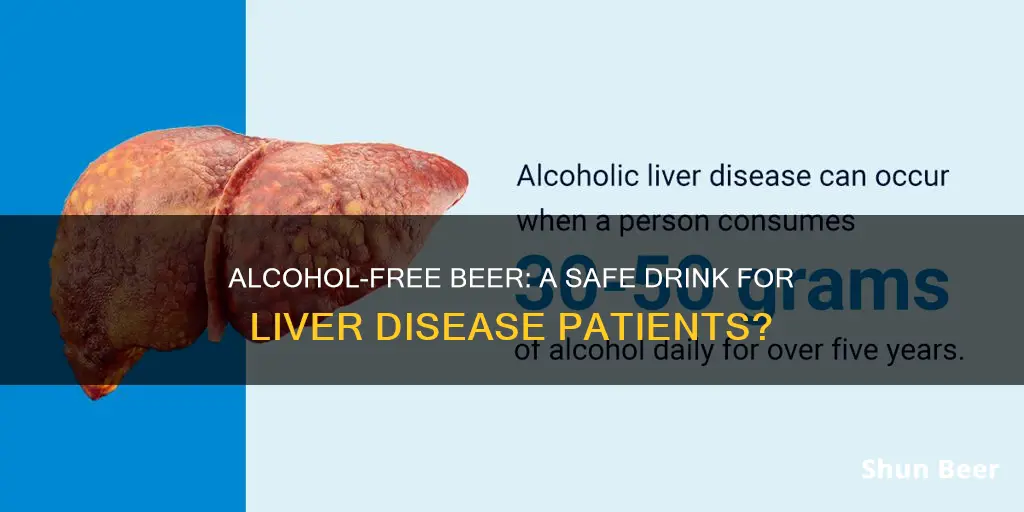
Alcohol-related liver disease (ARLD) is a common condition in the UK, caused by drinking too much alcohol. The liver is one of the most complex organs in the body, performing a wide range of functions, including filtering toxins from the blood and aiding digestion. Each time the liver filters alcohol, some liver cells die, and while the liver can develop new cells, prolonged alcohol misuse over many years can reduce its ability to regenerate, leading to serious and permanent damage. ARLD has several stages of severity, including alcoholic fatty liver disease, alcoholic hepatitis, and cirrhosis. The condition is often diagnosed during tests for other conditions or when it has reached an advanced stage, as it usually doesn't cause symptoms until the liver has been severely damaged. The most effective way to prevent ARLD is to stop drinking alcohol or stick to the recommended limits. A 2020 study found that non-alcoholic beer was safe and well-tolerated by patients with liver cirrhosis, improving their quality of life. Therefore, non-alcoholic beer is likely a safe and healthy choice for those without liver damage.
| Characteristics | Values |
|---|---|
| Alcohol-free beer's impact on the liver | Safe and well-tolerated by people with liver cirrhosis |
| Alcoholic beer's impact on the liver | Can cause liver disease and liver cancer |
What You'll Learn
- Non-alcoholic beer has been shown to be safe for people with liver cirrhosis, improving their quality of life
- Alcoholic beer can cause serious liver damage, including cirrhosis, if consumed in excess
- Alcoholic beer can cause acute hepatitis, an acute inflammation of the liver that can lead to permanent scarring
- Alcoholic fatty liver disease is the first stage of alcohol-related liver disease and is reversible by abstaining from alcohol
- Abstaining from alcohol is the best way to prevent and treat alcohol-related liver disease, but it can be challenging for those with alcohol dependency

Non-alcoholic beer has been shown to be safe for people with liver cirrhosis, improving their quality of life
A 2020 study found that non-alcoholic beer improved the quality of life of patients with liver cirrhosis. The study, which included 43 patients, found that non-alcoholic beer was well tolerated and resulted in improvements in nutritional status, endothelial function, and quality of life. The study concluded that non-alcoholic beer, in combination with diet and exercise, could be a safe and effective treatment for people with liver cirrhosis.
Another study found that non-alcoholic beer can improve blood circulation, prevent thrombosis, and reduce the risk of clogged arteries. These effects can contribute to the healthy functioning of the kidneys, which work closely with the liver to maintain overall health.
It is important to note that while non-alcoholic beer may be a safer alternative, it is not completely alcohol-free. In the United States, products labeled as "non-alcoholic" can contain up to 0.5% alcohol. For individuals with liver disease, it is best to consult a doctor before consuming any amount of alcohol.
Miller Beer Text Rebates: How Do They Work?
You may want to see also

Alcoholic beer can cause serious liver damage, including cirrhosis, if consumed in excess
Alcoholic liver disease is a common but preventable condition. It is caused by the heavy consumption of alcohol, which the liver breaks down. If you drink more alcohol than your liver can process, it can become badly damaged.
The liver is a large organ that sits under the ribs on the right side of the abdomen. It performs a wide range of important metabolic functions, including processing nutrients in our diet and converting them into substances that our bodies can use, and filtering and breaking down toxic substances.
Alcoholic liver disease can progress through three types: steatotic (fatty) liver, acute hepatitis, and cirrhosis. Steatotic liver is the most common alcohol-induced liver problem and occurs when there is a build-up of fat inside liver cells, leading to an enlarged liver. Alcohol-associated hepatitis is an acute inflammation of the liver, which can be followed by permanent scarring. Finally, cirrhosis is the destruction of normal liver tissue, leaving scar tissue in its place. In this situation, the liver may stop functioning correctly.
According to the NHS, even 2-3 alcoholic drinks per day over a long period can harm your liver, and binge drinking of 4-5 drinks per day can cause serious liver damage. Long-term alcohol overuse can inhibit the liver's ability to break down and remove harmful substances from your body, increasing the risk of chronic liver inflammation and cirrhosis.
The effects of alcohol on the liver depend on the amount consumed and the duration of consumption. The most important part of treatment for alcoholic liver disease is to stop drinking alcohol completely. With complete alcohol avoidance and time, the liver can often heal and recover some of its functions, allowing individuals to return to a normal life. However, in cases of severe damage, the liver may not be able to heal or return to normal function, and a liver transplant may be necessary.
In conclusion, alcoholic beer can cause serious liver damage, including cirrhosis, if consumed in excess. It is important to monitor alcohol intake and seek medical advice if you are concerned about your drinking habits or liver health.
The Science of Nostalgia: Beer Cooler Edition
You may want to see also

Alcoholic beer can cause acute hepatitis, an acute inflammation of the liver that can lead to permanent scarring
Alcoholic liver disease is a common but preventable condition. Alcoholic hepatitis, one of the three types of alcohol-associated liver disease, is an acute inflammation of the liver that can lead to permanent scarring. The condition can be mild or severe, and in severe cases, a person may require a liver transplant if they do not receive treatment or stop consuming alcohol.
The liver is the body's second-largest organ, located under the rib cage on the right side of the torso. It plays a crucial role in converting food and drinks into nutrients that the body can easily use, as well as filtering poisons and harmful substances, including alcohol, from the blood. When the liver is overloaded with alcohol, it metabolises it, breaking it down into poisonous chemicals. This process can damage and destroy liver cells, leading to inflammation and scarring.
Heavy and frequent alcohol consumption is the main cause of alcoholic hepatitis. The process of breaking down large amounts of alcohol in the liver causes inflammation, which can destroy liver cells. Over time, scars begin to replace functional liver tissue, interfering with the liver's ability to function properly. This irreversible scarring, known as cirrhosis, is the final stage of alcoholic liver disease.
The effects of alcoholic beer consumption on the liver can be both short and long-term. In the short term, drinking more alcohol than the liver can process leads to alcohol accumulation in the blood and bodily tissues. According to the NHS, even 2-3 alcoholic drinks per day over an extended period can harm the liver, while binge drinking of 4-5 drinks per day can cause serious liver damage. Long-term alcohol overuse inhibits the liver's ability to remove harmful substances, increasing the risk of chronic liver inflammation and cirrhosis.
Alcoholic hepatitis can be mild or severe, and it is possible to reverse the condition in its early stages by abstaining from alcohol. However, severe alcoholic hepatitis can lead to life-threatening complications such as liver failure. Once the condition becomes severe, symptoms may include a buildup of fluid in the upper body, confusion, behaviour changes, and liver and kidney failure.
The treatment for alcoholic hepatitis focuses on stopping alcohol consumption. Abstinence from alcohol may help prevent the condition from progressing and, in early diagnosis cases, can help reverse liver damage. In more advanced cases, liver transplantation may be necessary for survival.
Mouthwash Beer Spray: Effective Mosquito Repellent?
You may want to see also

Alcoholic fatty liver disease is the first stage of alcohol-related liver disease and is reversible by abstaining from alcohol
Alcoholic liver disease is a spectrum of disorders that begins with a fatty liver and can progress to alcoholic hepatitis and, ultimately, alcoholic cirrhosis—the most advanced and irreversible form of alcohol-induced liver damage. The first stage of alcoholic liver disease is alcoholic fatty liver disease, also known as steatosis. This condition occurs when fat accumulates in the liver parenchyma due to excessive alcohol consumption. The liver is resilient and can regenerate itself, but prolonged alcohol misuse over many years can reduce its ability to recover, leading to serious and permanent damage.
Alcoholic fatty liver disease rarely causes any noticeable symptoms, but it serves as an important warning sign that an individual is drinking at a harmful level. Fortunately, this condition is reversible by abstaining from alcohol. If a person stops drinking alcohol for an extended period, typically months or years, their liver should return to normal. However, it is crucial to act promptly, as continued alcohol consumption can lead to more severe forms of alcoholic liver disease, which may have irreversible consequences.
In addition to abstaining from alcohol, individuals with alcoholic fatty liver disease may need to make dietary changes and participate in an alcohol use disorder treatment program to support their recovery. Seeking medical advice and being honest about alcohol consumption is essential to receiving proper care and preventing further liver damage.
The Art of Distilling: Brewing Beer, Simplified
You may want to see also

Abstaining from alcohol is the best way to prevent and treat alcohol-related liver disease, but it can be challenging for those with alcohol dependency
Alcohol-associated liver disease is a common but preventable disease. Abstaining from alcohol is the best way to prevent and treat alcohol-related liver disease. The liver's job is to break down alcohol, and if you drink more than it can process, it can become badly damaged.
Heavy alcohol use is defined as consuming more than 14 grams of pure alcohol (ethanol) per day for men and more than 12 grams for women. This is equivalent to five drinks per day for men and four drinks per day for women. Binge drinking and long-term alcohol overuse can inhibit the liver's ability to break down and remove harmful substances from the body, increasing the risk of chronic liver inflammation and cirrhosis.
While abstinence from alcohol is crucial for preventing and treating liver disease, it can be challenging for those with alcohol dependency. Alcohol use disorder (AUD) is a serious medical condition that can lead to adverse social, occupational, or health consequences and make it difficult to stop or control alcohol consumption. Genetics and environmental factors, such as family history, peer pressure, and stress, can contribute to the development of AUD.
For individuals with AUD, having just one drink can be the catalyst for a full-blown relapse. Alcohol alters brain chemistry, reduces inhibitions, and blurs judgment, potentially leading to alcohol dependence. This slippery slope can make it extremely difficult for individuals to maintain control over their drinking habits, even if they initially intended to practice casual drinking.
The decision to abstain from alcohol or attempt moderate drinking varies for each individual, and factors such as personal history, genetics, and environmental influences play a role. Abstinence is a powerful recovery strategy as it eliminates the risk of relapse and helps break the illusion of control that many alcoholics have. It allows individuals to stay focused on their recovery journey without constantly struggling to resist the urge to drink.
However, moderation may be more suitable for those without a history of alcohol addiction or dependence, as they can enjoy an occasional drink without compromising their health. It is crucial to recognize the potential dangers of returning to alcohol after sobriety, as it could be detrimental to one's health and well-being.
Support groups, therapy, and other resources can provide invaluable assistance in managing addiction and maintaining recovery. Seeking professional help can empower individuals to take control of their recovery journey and resist the temptation to drink alcohol. Resources like Alcoholics Anonymous (AA) have been found to be highly effective in helping individuals achieve sobriety and are based on social interaction, providing emotional support, and practical tips to refrain from drinking.
Parked, Drinking Beer: Legal or Not?
You may want to see also







